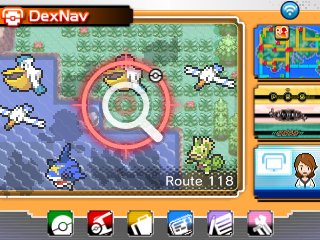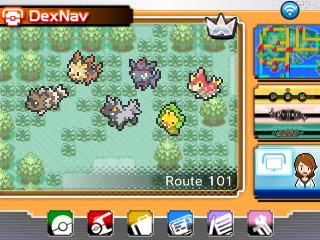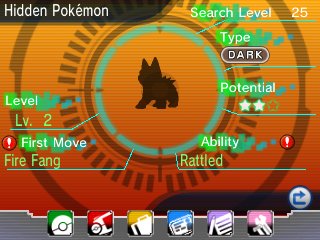The PokéNav Plus has been greatly improved upon in Pokémon Omega Ruby and Alpha Sapphire, and is quickly proving itself as one of the best bottom-screen features ever implemented into a Pokémon game. Pokémon X and Y nailed it with the Player Search System, as well as the welcome additions of Pokémon Amie–which let you interact with your Pokémon using the touch screen–and Super Training–which streamlined competitive EV training and added a chart to keep track of your Pokémon’s progress.
These features made it back in Omega Ruby and Alpha Sapphire within the PlayNav app of the PokéNav Plus, along with the BuzzNav, the AreaNav, and–today’s star–the DexNav.
The DexNav
The DexNav is the second app that gets installed on your PokéNav Plus while playing through the introductory sequence of Pokémon Omega Ruby and Alpha Sapphire. You get this special app installed by your rival, Brenden/May, right after receiving the Pokédex.

When being introduced to this feature of the game, you will encounter a wild Poochyena with its tail sticking up in the tall grass, nearby. If you simply walk up to this spot in the grass, the Pokémon is going to get spooked and flee. GameFreak has, however, added the ability to sneak if you softly nudge the Circle Pad in the given direction. So long as you can see your character tip-toeing around like a dork, you’re in the clear.
At first glance, this feature reminds me of a randomized PokéRadar. You aren’t restricted to Pokémon that only appear in shaking grass, like it was in Pokémon Black and White; instead, you can find any Pokémon from any location using this method (not including in-game event Pokémon).
What does the DexNav do?
The DexNav app on your PokéNav Plus helps you track your progress with this feature, as well as predict some of the aspects of the Pokémon that are rustling the grass. After gaining the ability to surf, shaking spots begin to appear in the water–and they aren’t restricted to surface-only Pokémon.
 Upon activation of the DexNav app, you will see the icons of Pokémon–or light silhouettes of Pokémon–spaced on a GBA-era map of your current location. Their placement on the map matches the environment where they are found (such as a Magikarp icon in the water).
Upon activation of the DexNav app, you will see the icons of Pokémon–or light silhouettes of Pokémon–spaced on a GBA-era map of your current location. Their placement on the map matches the environment where they are found (such as a Magikarp icon in the water).
The icons represent Pokémon that have already been registered in the trainer’s Pokédex. Silhouettes account for Pokémon that have been encountered but not registered. Pokémon that have been neither encountered nor registered won’t show up on the DexNav at all.
Why you should use the DexNav
It’s easier to check whether you have caught every Pokémon in an area using the DexNav instead of opening your Pokédex. The DexNav will give the trainer an indication of how close they are capturing every Pokémon in an area if you tap on the map. These are also indicated by a series of crowns that appear in the upper-right hand corner of the app:
- A Bronze Crown appears when you are making headway in an area, but may not have every option for encountering Pokemon in the wild yet.
- A Silver Crown appears when you are getting close to catching every Pokémon in the area.
- A Golden Crown appears when you have caught every Hoenn-native Pokémon in an area.
- A Platinum Crown appears when you have caught every single Pokémon in a given area.

After the grand encounter with Primal Groudon and Primal Kyogre, players can return to Littleroot Town and receive the National Dex. The National Dex will unlock three new Pokemon in almost every area of the game, leaving much more to collect after Omega Ruby and Alpha Sapphire‘s epic climax.
Every time you encounter a specific Pokémon, its own Search Level will rise by one–even if you haven’t captured it yet. As the Search Level increases, the DexNav will be able to predict more about each Pokémon, and your chances of finding more unique Pokémon increase as well.
When sneaking up on Pokémon, the DexNav can tell you the following:
- Level – Level of the Pokémon (potential for elevation)
- Type – Typing of the Pokémon.
- First Move – First Move the Pokémon knows (potential for an Egg Move)
- Ability – Ability the Pokémon has (potential for the Hidden Ability)
- Potential (Stars) – How many stats the Pokémon has with maxed IVs (potential for three)

After catching a Pokémon, the trainer can tap on their icon in the DexNav interface to search for them. If there are any around, the grass/water will start shaking, like normal.
This could be used as a new chaining system for Shiny Pokémon. Chaining doesn’t only work with the PokéRadar–the rules of chaining remain the same whether you are using the PokéRadar or not, but there was previously no other way to run into the same Pokémon multiple times.
 While testing out the chaining capabilities of the DexNav, it’s been found that if you run away from the battle, it will appear as if the Pokémon isn’t around when you try to search for it again. This happens every time, so make sure that you K.O./catch every Pokémon so you don’t break your chain–these rules remain constant from the PokéRadar method, furthering my belief that the DexNav is a replacement for the PokéRadar.
While testing out the chaining capabilities of the DexNav, it’s been found that if you run away from the battle, it will appear as if the Pokémon isn’t around when you try to search for it again. This happens every time, so make sure that you K.O./catch every Pokémon so you don’t break your chain–these rules remain constant from the PokéRadar method, furthering my belief that the DexNav is a replacement for the PokéRadar.
Unlike the PokéRadar, the DexNav is not restricted to tall grass, and you can leave the patch of grass that you are in without worrying about breaking your chain.
Now we have another method for catching shiny versions of the Pokémon in the sea–and it’s not random, like Chain Fishing.
How to get the most out of your DexNav
There are two rules that you should follow when trying to raise the efficiency of the DexNav:
- Never, ever use repels. Every encounter with a Pokémon will raise its very own Search Level in the DexNav–even if you run away! It’s always worth getting that extra level, because you never know when it could be the difference between finding the right Pokémon or not.
- Catch every new Pokémon you come across. It may seem nice brushing through the game, catching only the Pokémon that you know you’re going to use, but it doesn’t help the DexNav one bit. There are many things the DexNav is useful for, but you’re not going to get anything out of it if you don’t catch the Pokémon that show up. This can save you a lot of time and hassle that is otherwise spent praying to the gods of RNG.
The DexNav is the app that I have almost always open in the PokeNav Plus. There has never been a better time to try to catch them all.






Published: Nov 25, 2014 09:23 am